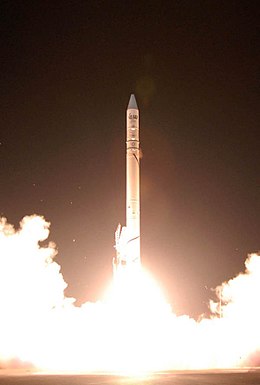Ofeq
 | |
| Manufacturer | Israel Aerospace Industries |
|---|---|
| Country of origin | Israel |
| Operator | Israeli Ministry of Defence/Tsahal |
| Applications | Reconnaissance |
| Specifications | |
| Regime | Low Earth orbit |
| Production | |
| Status | Active |
| Built | 13 |
| Launched | 13 |
| Maiden launch | 19 September 1988 (Ofeq-1) |
| Last launch | 29 March 2023 (Ofeq-13) |
Ofeq,also spelledOffekorOfek(Hebrew:אופק,lit.Horizon) is the designation of a series ofIsraelireconnaissance satellitesfirst launched in 1988. Most Ofeq satellites have been carried on top ofShavitlaunch vehicles fromPalmachim Airbasein Israel, on theMediterraneancoast. Thelow Earth orbitsatellites complete oneEarth orbitevery 90 minutes.
The satellite launches madeIsraeltheeighth nationto gain an indigenous launch capability. Both the satellites and the launchers were designed and manufactured byIsrael Aerospace Industries(IAI) withElbit Systems' El-Op division supplying the optical payload.
Description
[edit]While exact technical details and capabilities are classified, it is assumed that the Ofeq satellites have an effective operational lifespan of 1–3 years andultravioletandvisibleimaging sensors, except Ofeq-8 and -10 which utilizesynthetic-aperture radar(SAR) for all-weather and nighttime reconnaissance. Some reports place the imaging resolution at 80 cm for Ofeq-5.[citation needed]
Most satellites are launched eastward to gain a boost from the Earth's rotational speed. However, Ofeq satellites are launched westward, inretrograde orbits,over the Mediterranean to avoid flying over, and dropping spent rocket stages over, populated land areas. Other Israeli satellites, such as theAMOSseries, are launched from locations in other countries.[1]
Orbital characteristics
[edit]Ofeq's east-to-west orbit of 143.0°orbital inclinationis phased to give good daylight coverage of theMiddle East.[2]SomeAmericanandRussianobservation satellites havenear-polar orbitsand make between 14 and 16 orbits per day, but pass over Israel on fewer orbits. Spacecraft need to reach roughly 27,000 km/h (7,500 m/s) to achieve low Earth orbit.
At 31.88°N, the latitude of Palmachim Airbase, where the angular velocity of the Earth is around 1,420 km/h (390 m/s) to the east,westwardlaunched Ofeq satellites must use more fuel to counter starting going 1,420 km/h the opposite direction. Manyother observation satelliteswith prograde orbits have the same maximum latitude and cover the same areas of the Earth. However the retrograde orbit of Ofeq increases the relative speed to the surface of the Earth and thusly increases the average number of times they pass over Israel on each revolution.
Ofeq satellites make a half-dozen or so daylight passes per day over Israel and the surrounding countries, whereas non-Israeli observation satellites in Sun-synchronous orbits get one or two passes per day from their lower inclination orbits.
Since its launch in 2002, Ofeq-5's orbital inclination of 143.4 has been the most-inclined orbit of all of Earth'sartificial satellites.[3]
Satellite List
[edit]| Designation | Type | Launch Date | Carrier Rocket | End of Mission Date | Notes |
|---|---|---|---|---|---|
| Ofeq-1 | Experimental | September 19, 1988 | Shavit-1 | January, 1989 | |
| Ofeq-2 | Experimental | April 23, 1990 | Shavit-1 | July, 1990 | |
| Ofeq-3 | IMINT | September 15, 1994 | Shavit-1 | October, 1996 | Israel's first operational IMINT satellite |
| Ofeq-4 | IMINT | January 22, 1998 | Shavit-1 | Launch Failure | Did not achieve orbit |
| Ofeq-5 | IMINT | May 28, 2002 | Shavit-1 | February 21, 2024 | New generation of IMINT satellite |
| Ofeq-6 | IMINT | September 6, 2004 | Shavit-1 | Launch Failure | Crashed into the Mediterranean Sea |
| Ofeq-7 | Reconnaissance | June 10, 2007 | Shavit-2 | In Orbit | First launch with the Shavit-2. |
| Ofeq-8 | TecSAR-1 | January 21, 2008 | Shavit-2 | In Orbit | |
| Ofeq-9 | Reconnaissance | June 22, 2010 | Shavit-2 | In Orbit | |
| Ofeq-10 | TecSAR-2 | April 9, 2014 | Shavit-2 | July 14, 2024 | De-orbit complete July, 2024. |
| Ofeq-11 | IMINT | September 13, 2016 | Shavit-2 | June 29, 2024 | Was equipped with the Jupiter High-Resolution Imaging System. |
| Ofeq-16 | IMINT | July 6, 2020 | Shavi-2 | In Orbit | |
| Ofeq-13 | TecSAR-3 | March 28, 2023 | Shavit-2 | In Orbit |
References
[edit]- ^"AMOS-1 → Intelsat 24".space.skyrocket.de.18 November 2019.Retrieved8 May2021.
- ^Stephen Clark (10 April 2014)."All-weather surveillance satellite put in orbit by Israel".Spaceflight Now.Retrieved12 April2014.
- ^"UCS Satellite Database - Union of Concerned Scientists".Union of Concerned Scientists.Retrieved23 May2022.
